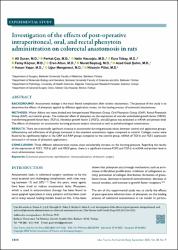Investigation of the effects of post-operative intraperitoneal, oral, and rectal phenytoin administration on colorectal anastomosis in rats

Göster/
Erişim
info:eu-repo/semantics/openAccessTarih
2022Yazar
Duran, AliÇay, Ferhat
Hacıoğlu, Nelin
Tokay, Esra
Köçkar, Feray
Altun, Eren
Başbuğ, Murat
Şahin, Azad Gazi
Üst veri
Tüm öğe kaydını gösterÖzet
BACKGROUND: Anastomotic leakage is the most feared complication after colonic anastomosis. The purpose of the study is to determine the effects of phenytoin applied by different application routes, on the healing process of colorectal anastomoses. METHODS: Wistar Albino rats were divided into Intraperitoneal Phenytoin Group, Oral Phenytoin Group (OAP), Rectal Phenytoin Group (RAP), and control groups. The molecular effect of phenytoin on the expression of vascular endothelial growth factor (VEGF), transforming growth factor-beta (TGF-beta), fibroblast growth factor 2 (FGF2), and p53 genes was evaluated at mRNA and protein level. The effects of phenytoin on anastomotic bursting pressure analysis measured as well as pathohistological examinations. RESULTS: There are statistically significant increase in anastomotic bursting pressure values between control and application groups. Inflammatory cell infiltration of all groups increased in the intestinal anastomosis region compared to control. Collagen scores were found to be significantly higher in the OAP and RAP groups compared to the control group. mRNA of TGF-beta and FGF2 expression increased in all routes of phenytoin applications. CONCLUSION: Three different administration routes show considerably increase on the bursting pressure. Regarding the results of the expression of FGF2, TGF-beta, p53, and VEGF genes, there is a significant increase FGF2 and TGF-beta at mRNA and protein level in most administration routes. AMAÇ: Anastomoz kaçağı kolon anastomozlarından sonra en korkulan komplikasyondur. Bu çalışmanın amacı, farklı uygulama yollarıyla uygulanan
fenitoinin kolorektal anastomozların iyileşme sürecine etkisini belirlemektir.
GEREÇ VE YÖNTEM: Wistar Albino sıçanlar, İntraperitoneal Fenitoin Grubu (İAP), Oral Fenitoin Grubu (OAP), Rektal Fenitoin Grubu (RAP) ve
kontrol gruplarına ayrıldı. Fenitoinin VEGF, TGF-β, FGF2 ve p53 genlerinin ekspresyonu üzerindeki moleküler etkisi mRNA ve protein düzeyinde
değerlendirildi. Fenitoinin anastomoz patlama basıncı analizi üzerindeki etkilerinin yanı sıra patohistolojik incelemeler de ölçülmüştür.
BULGULAR: Kontrol ve uygulama grupları arasında anastomoz patlama basıncı değerlerinde istatistiksel olarak anlamlı artış vardır. Enflamatuvar
hücre infiltrasyonu tüm gruplarda kontrole göre bağırsak anastomoz bölgesinde artmıştır. Kollajen skorları OAP ve RAP gruplarında kontrol grubuna
göre anlamlı derecede yüksek bulundu. TGF-ß’nin mRNA’sı ve FGF2 ekspresyonu, fenitoin uygulamalarının tüm yollarında artmıştır.
TARTIŞMA: Üç farklı uygulama yolu, patlama basıncında önemli bir artış göstermektedir. FGF2, TGF-β, p53 ve VEGF genlerinin ekspresyon sonuçları ile ilgili olarak, çoğu uygulama yolunda mRNA ve protein seviyesinde FGF2 ve TGF-β’de önemli bir artış vardır.

















